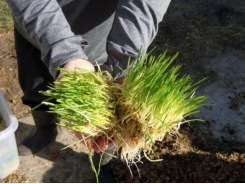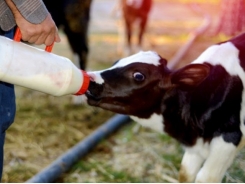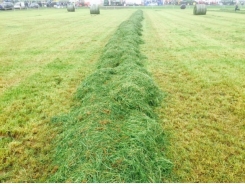Method converts dairy waste water to animal feed, fuel

Photocredit: Lars Angenent, University of Tübingen. The bio-oil made from acid whey could be used as animal feed or aviation fuel.
A University of Tübingen biotechnologist seeks to recycle waste with the ultimate aim of creating a sustainable cycle of materials.
Scientists at the University of Tübingen in Germany have developed a bioprocess that enables conversion of acid whey, a dairy byproduct, without the use of additional chemicals.
Professor Lars Angenent from the Center of Applied Geosciences at the University of Tübingen and international colleagues used microbiome cultures similar to those in the human gut. The new bio-oil can be used in animal feed or, after further refinement, as a fuel for airplanes.
The results of the study were published in Joule, a new premier journal from CellPress.
Every liter of milk that goes into milk products, such as quark and Greek yogurt, or into fresh cheeses, produces another two liters of wastewater in the dairy factory. This wastewater is called “acid whey” and cannot be fed to animals in large quantities due to its acidity. It is rich in organic material like lactose and must be treated or transported to farms for use as a fertilizer by spreading it on land, the university explained.
Angenent, the Humboldt professor for environmental biotechnology at the University of Tübingen, studies how these large volumes of wastewater can be turned into valuable products. He used a tank with many different types of bacteria, called a reactor microbiome.
“This microbiome is an open culture, which means bacteria from the outside environment can also enter and grow, similar to our gut microbiome. No sterilization of the tank or wastewater is necessary,” he explained. “The bacteria are selected and tricked to elongate the carbon backbone of chemicals by a process that we call chain elongation.”
Angenent added, “We kept two microbiomes under different temperatures and placed them in series. The first hot microbiome (50°C) converts all the sugars into an intermediate acid ‒ the same acid that makes milk in your fridge taste sour if you keep it there too long. The second warm microbiome (30°C) performs chain elongation until a product is formed with six to nine carbons in a row.”
Angenent’s research group for Environmental Biotechnology investigated which bacteria had grown in the two different microbiomes.
“The new product could be fed back to the animal as an antimicrobial to prevent disease, or it can be further processed in a refinery into aviation fuel,” Angenent said. Because the product from the bioreactor microbiome has six to nine carbons in a row, it becomes more oil-like and can be separated from the water it was produced in, he said. After that it must still be purified and further refined.
“We are making a bio-oil that the bacteria excrete,” Angenent said. “The innovation of the research is that the process does not need any other carbon-rich chemicals and only needs the waste water itself. In the past, chain elongation needed external, expensive chemicals.”
The production of bio-oil is part of the development of a circular economy, in which all wastes are recycled into valuable products. “Only a completely circular economy can be sustainable with all energy coming from renewable sources, while carbon for chemicals is coming from waste carbon dioxide and other carbon-rich wastes such as acid whey,” Angenent concluded.
More work is now needed to study if other types of wastewater can also be converted into these valuable chemicals.
Có thể bạn quan tâm
Phần mềm

Phối trộn thức ăn chăn nuôi

Pha dung dịch thủy canh

Định mức cho tôm ăn

Phối trộn phân bón NPK

Xác định tỷ lệ tôm sống

Chuyển đổi đơn vị phân bón

Xác định công suất sục khí

Chuyển đổi đơn vị tôm

Tính diện tích nhà kính

Tính thể tích ao hồ




 What role does ruminal microbiome plays in determining…
What role does ruminal microbiome plays in determining…  Cutting silage? Here’s how to make the neighbours…
Cutting silage? Here’s how to make the neighbours…